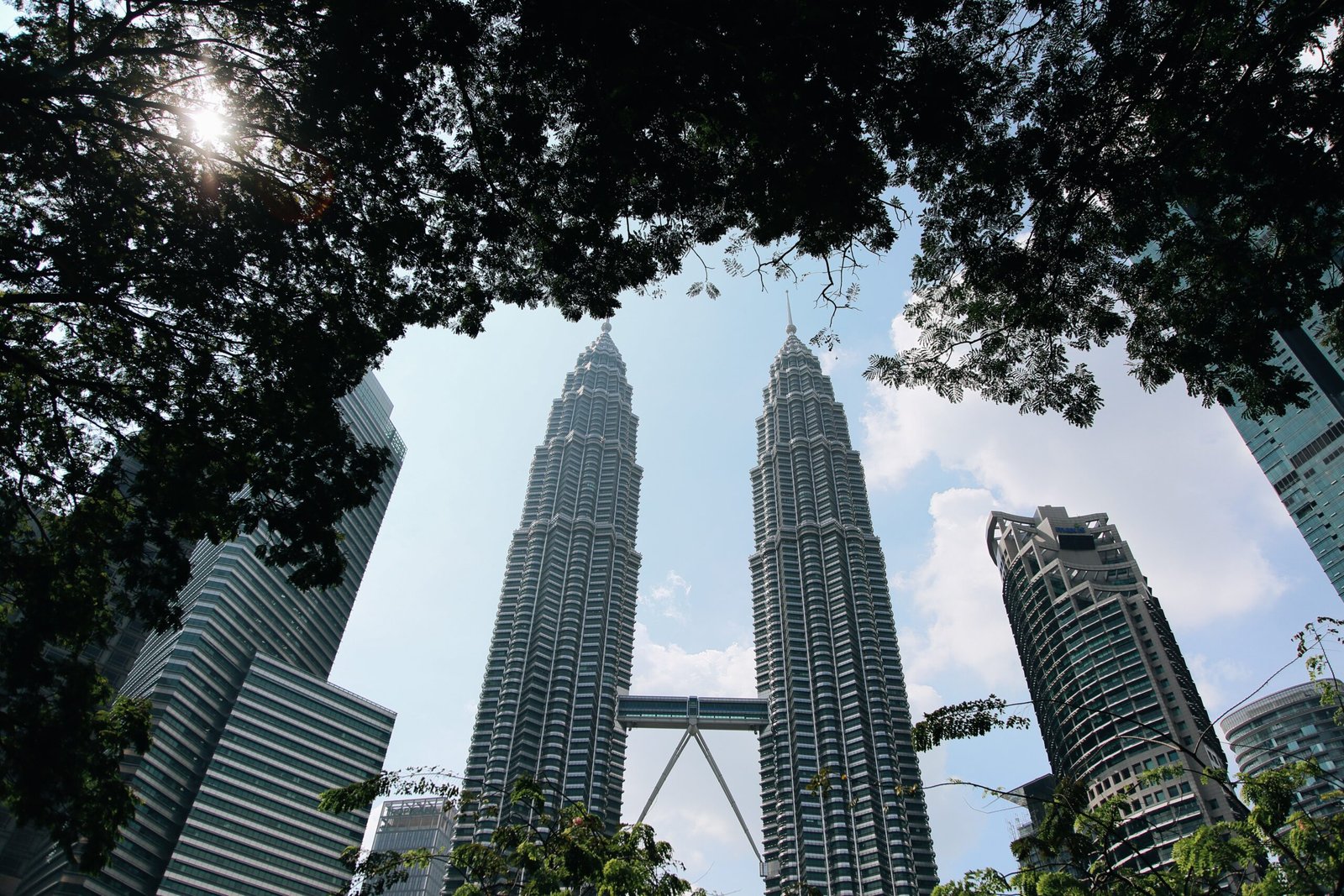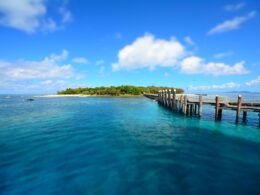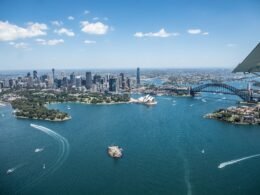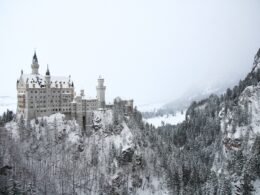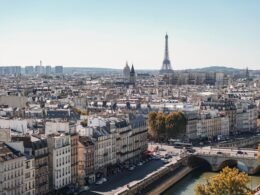Kuala Lumpur is Malaysia’s vibrant capital and a must-visit for anyone heading to Southeast Asia. It’s a vast melting pot of cultures with a blend of Indian, Malay, Chinese, and Western influences.
With great food, buzzing nightlife, and some serious shopping, KL is definitely a bucket-list destination. Our ultimate guide to visiting Kuala Lumpur below includes what to see, the best places to eat, plus some other handy tips. So keep reading!
Things to see and do
Visit one of the city’s many temples

One of the best things about Kuala Lumpur (and Malaysia in general) is it’s high levels of cultural diversity. It’s thanks to this that the city is home to numerous temples, from Islamic mosques to Buddhist temples, to Hindu Mandirs. The best temples to visit are the Jamek Mosque, the Thean Hou Temple, and the Sri Mahamariamman Temple.
The Jamek Mosque is one of the oldest in the city, with spectacular Moorish-style architecture, white domes, and towering palm trees. The Thean Hou Temple is one of the largest of its kind in Southeast Asia. The Chinese temple has intricate roofing, ornate carvings, and beautiful murals. The best time to visit is at night when the courtyard is lit by hundreds of lanterns!
The Sri Mahamariamman Temple is the oldest Hindu temple in Kuala Lumpur. It dates back to 1873, although the breathtaking ‘Raja Gopuram’ tower was added in 1968. The tower is one of the temple’s most outstanding features, built in the South Indian style, and decorated with statues of Hindu gods.
Take a day trip to the Batu Caves

Whilst the Batu Caves aren’t technically in Kuala Lumpur, they’re only 8 miles (13 km) north of the city and easy to reach via train, bus, or taxi. The whole complex is stunning, and the main limestone cavern (known as Cathedral Cave or Temple Cave) sits at the top of 272 rainbow-painted steps! The cave houses several temples and shrines and has a huge natural skylight. On sunny days the skylight brightens the inside with gorgeous rays of sunshine.
There are several other caves nearby, one halfway up the stairs known as the Dark Cave (which has been closed indefinitely since January 2019), and two more at the bottom of the hill. Aside from the caves, the main highlight of the complex is the iconic 140 ft (42.7 m) gold-painted statue of Murugan, a Hindu god. It’s the second tallest Murugan statue in the world and took three years to build.
The Batu Caves are amazing year-round, but they can get particularly crowded during Hindu holidays. When visiting, you should watch out for the resident macaque monkeys who (from experience) will grab anything they can… including your expensive camera!
Admire the city’s modern architecture

Kuala Lumpur may be full of history, but it’s also a thriving metropolitan and the economic centre of Malaysia. Throughout the city centre there are marvelous examples of modern architecture, with many of these buildings becoming tourist attractions in their own right.
No visit to the city would be complete without visiting the world-renowned Petronas Towers. These two towers are the tallest twin towers in the world, standing at 1,483 ft (451.9 m) high with 88 floors. Whizz all the way up to the 86th floor to the observation deck for amazing views over the city, of the neighboring tower, and interactive exhibits.
If you’d rather enjoy the view from the ground, head to KLCC Park for the fantastic views of the Kuala Lumpur skyline. The 50-acre urban park is lovely during the day, with water fountains, footpaths, and greenery. But, we think it’s most spectacular once the sun sets.
Make your way to the pond across from the Petronas Towers for a light-up fountain display and a backdrop of the big city lights.
Recharge in Kuala Lumpur’s beautiful parks

Kuala Lumpur has plenty of outdoor spaces and they’re a great place to spend a morning or afternoon! One of the most popular parks is the Perdana Botanical Gardens, the first large-scale recreational park in the city. Another must-visit is the KL Forest Eco Park, one of the country’s oldest permanent forest reserves.
The Perdana Botanical Gardens (formerly known as Lake Gardens) spans 226 acres. It dates back to 1888 and is in the heart of the city. At the centre of the main gardens, there’s a large futuristic building/sculpture (a fab photo spot) surrounded by trees. Other interesting attractions are the 20.9-acre bird park (with over 3,000 birds), the hibiscus garden, and the butterfly park (with more than 5,000 live butterflies!).
In our opinion, the KL Forest Eco Park is one of the most scenic parks in the city. The 22-acre park is a lush oasis amid towering skyscrapers and city traffic. There are several scenic trails through the trees, but the 656 ft (200 m) high canopy walk is the main highlight. Try to visit before 10 am on a weekday if you want a great picture of yourself on the treetop bridge without the crowds! #forthegram
Spend the day doing some serious shopping

We all love a good holiday shopping spree, and luckily, Kulala Lumpur has some world-class shopping and great markets. If you want to blow your budget on top designer brands, stock up on your skincare, or even catch a movie, then Suria KLCC is the place to go. For authentic souvenirs and local handicrafts, head to Central Market.
Suria KLCC is a huge six-storey shopping mall at the base of the Petronas Towers. It’s got big name brands and designer stores plus plenty of places to eat. Our top tip is to get a Tourist Privilege Card from the concierge (for international tourists only) to get special discounts in certain stores.
Central Market is our go-to for souvenirs. Dating back to 1888, the market has over 300 stores selling textiles, handicrafts, and souvenirs. Shopping aside, it’s a great place to grab a local snack, with several food stalls lining the open-air Kasturi Walk outside.
Where to eat

Kuala Lumpur is a serious foodie destination and we definitely recommend stepping out of your comfort zone to try something new. Luckily, the city is no exception when it comes to delicious street-side dining, which has become synonymous with Southeast Asia. It’s easy to find somewhere to eat, but we recommend hitting up Jalan Alor Street, Tapak Urban Street Dining, and the night markets of Petaling Street.
Jalan Alor, in the heart of the city, is lined with restaurants and hawker stalls. Once the red light district area of Kuala Lumpur, nowadays, it’s a chaotic (and super fun) dinner-time destination for locals and tourists. If you’re feeling adventurous, brave the frog porridge or oyster omelettes!
It’s best to arrive in Petaling Street from late afternoon as most of the stalls aren’t open during the day. This busy street in Chinatown houses some of the country’s oldest food stalls, including the legendary Sze Ngan Chye Salted Roast Duck and Madam Tang Muah Chee. If Chinatown and Jalan Alor don’t tempt you, head to Tapak Urban Street Dining, a food truck park serving everything from loaded nachos to churros.
Where to stay

In a sprawling metropolis like Kuala Lumpur, it can be difficult figuring out the best area to stay. KLCC or the Kulala Lumpur City Centre is a great option for families or for those of you who are after a little luxury (and don’t mind paying). There’s a good choice of mid-range hotels and high-end hotels like the Hilton or the Mandarin Oriental. KLCC has plenty of places to eat, good public transport links, and amazing views of the Petronas Towers.
If you’re on a budget or are looking for an area with a backpacker feel, then Chinatown is your best bet. There’s a load of hostels to choose from, and you’ll have cheap eats right on your doorstep.
Bukit Bintang is by far our favorite area to stay in. As a hub of the city, it has accommodation to suit whatever you’re looking for, plus there’s a hip eclectic vibe. Eat out on Jalan Alor Street, party the night away at Changkat Bukit Bintang, or hang out in one of the trendy cafes.
How expensive is Kuala Lumpur?

So, how much does it cost to stay in Kuala Lumpur? Well, of course, that really depends on you and your spending habits… but according to budgetyourtrip, the average traveler spends MYR 218 ($49) a day and MYR 1,524 ($339) a week.
This is not too shabby at all, but there are always ways to make your trip more budget-friendly! You can find hostels for as cheap as $5 a night (admittedly not the best ones…), and if you stick to local street food, you could spend less than $10 a day eating out.
There are lots of free attractions like the Perdana Botanical Gardens, KLCC Park, and the National Art Gallery. It’s also free to visit the Temple Cave at the Batu Caves, and a one-way KTM Komuter train from KL Sentral only costs MYR 2.6 ($0.58).
The best time to visit

Kuala Lumpur has a warm, humid climate all year round, but it’s a good idea to time your visit to avoid the worst of the rains. The rainy season is officially from October to March, with November being the wettest month. However, it can rain at any time of the year, so you may want to carry an emergency raincoat.
June, July, and August are the driest months and for most, the best time to visit, however, prices can be a little higher compared to the off-season (February to March and September to October).
Kuala Lumpur has numerous festivals throughout the year that you may want to attend! These can be an amazing experience, but prices can be higher. Thaipusam (a Hindu festival in late January), Chinese New Year (in January or February), and the Moon Festival (a Chinese festival usually in September) are all celebrated in the city.
How to get around

There are numerous ways to get around the city, with an extensive rail network, tourist buses, and, for the most part, walkable streets. Taxis aren’t the most efficient way to get around, as they’re more expensive than public transportation and traffic can be a nightmare.
Exploring on foot is a great option if you’re staying in one area, however, if you want to walk between popular destinations such as Chinatown and Bukit Bintang, take extra care crossing any roads. The walking indicators on traffic lights aren’t always working and some drivers don’t pay any attention to them anyway!
Kuala Lumpur has a great rail system, consisting of three rail systems: the RapidKL LRT, the KL Monorail, and the KTM Komuter trains. Don’t be intimidated, as between them you can get anywhere you need to go! The KL Hop-On-Hop-Off Bus can be more convenient, with 22 stops at major attractions, but beware of rush hour and delayed pick-ups.
Local customs

Before you head off to have the time of your life in Kuala Lumpur, it’s a good idea to familiarise yourself with some of Malaysia’s local customs.
At markets, haggling is a way of life, and you’d be an absolute rookie to accept the first offer from the vendor. Make sure not to haggle in more established stores as this is considered to be rude.
When visiting places of worship, you should dress modestly with your shoulders and knees covered. The more popular temples tend to have scarves you can use in case you need to cover yourself up. Homosexual acts are illegal in Malaysia, and whilst public displays of affection are inappropriate for all couples, same-sex couples need to take extra care to avoid unwanted attention.
Final thoughts
Kuala Lumpur is a must-stop for anyone visiting Malaysia, or even Southeast Asia! As the country’s thriving capital, it’s full of history, incredible food, and wonderful attractions. It would be easy to spend anywhere from a couple of days to a week exploring its vibrant streets.
Hopefully, our ultimate guide to Kuala Lumpur has answered any questions you may have had about visiting this amazing city. If we’ve missed out on any of your favourite attractions or places to eat, drop us a message below!






